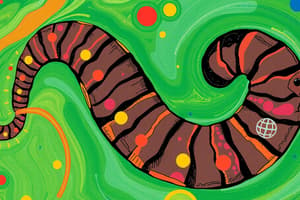Podcast
Questions and Answers
Which organism is primarily responsible for causing elephantiasis?
Which organism is primarily responsible for causing elephantiasis?
- Enterobius vermicularis
- Trichinella spiralis
- Dirofilaria immitis
- Wuchereria bancrofti (correct)
Which characteristic is NOT associated with the Phylum Rotifera?
Which characteristic is NOT associated with the Phylum Rotifera?
- Pseudocoelomate body structure
- Absence of a complete digestive system (correct)
- Presence of crown cilia
- Reproduction by parthenogenesis
What is the common mode of transmission for Enterobius vermicularis?
What is the common mode of transmission for Enterobius vermicularis?
- Direct contact with infected individuals
- Fecal-oral route (correct)
- Vector-borne transmission by mosquitos
- Transmission through contaminated water
What is the primary function of the protonephridia in rotifers?
What is the primary function of the protonephridia in rotifers?
Dirofilaria immitis is commonly known as what type of parasite?
Dirofilaria immitis is commonly known as what type of parasite?
What is the main feeding mechanism of rotifers?
What is the main feeding mechanism of rotifers?
Which statement regarding the reproductive strategies of rotifers is correct?
Which statement regarding the reproductive strategies of rotifers is correct?
What unique feature distinguishes the epidermis of certain rotifers?
What unique feature distinguishes the epidermis of certain rotifers?
What defines a pseudocoelomate organism?
What defines a pseudocoelomate organism?
Which of the following is a characteristic of nematodes?
Which of the following is a characteristic of nematodes?
What is the primary function of the muscular pharynx in nematodes?
What is the primary function of the muscular pharynx in nematodes?
Which feature is true regarding the reproductive system of most nematodes?
Which feature is true regarding the reproductive system of most nematodes?
How do nematodes primarily excrete nitrogenous waste?
How do nematodes primarily excrete nitrogenous waste?
What type of lifecycle does Ascaris lumbricoides exhibit?
What type of lifecycle does Ascaris lumbricoides exhibit?
What is the typical size range for nematodes?
What is the typical size range for nematodes?
What is a common characteristic of Necator americanus?
What is a common characteristic of Necator americanus?
Flashcards are hidden until you start studying
Study Notes
Pseudocoelomates
- Possess a pseudocoel, a body cavity partially lined with mesoderm.
- Known as false body cavity organisms or blastocoelomates.
Phylum Nematoda
- Commonly referred to as roundworms, they inhabit soil, fresh water, and salt water.
- Body form is long, slender, smooth, and tapering at both ends, ranging in size from 0.2 mm to 130 cm (52 inches).
Characteristics of Nematodes
- Triploblastic and bilateral, with a vermiform body plan.
- Unsegmented and classified as pseudocoelomates with a circular cross-section and only longitudinal muscles.
- Ecdysis involves shedding of collagenous cuticle during growth stages.
- Features a complete digestive tract including mouth, pharynx, intestine, rectum, and anus.
- Excretory system consists of collecting tubules or renette cells for waste elimination.
Structure and Function
- Nematode body is slender, cylindrical, and tapered at both extremities.
- Encased in a noncellular, collagenous cuticle.
- Some species possess lips around the mouth, with spines or teeth present.
Excretion
- Nitrogenous waste is excreted through two systems:
- Glandular system for aquatic species.
- Tubular system for parasitic roundworms.
Nervous System
- Comprised of an anterior neural ring with nerves extending both anteriorly and posteriorly.
Reproductive Development
- Majority are dioecious and exhibit sexual dimorphism.
Ascaris lumbricoides
- A prolific intestinal parasite found in pigs, horses, and occasionally humans, producing over 200,000 eggs daily.
Necator americanus
- Known as hookworm, these parasitic roundworms feed on blood and tissue fluids in the intestines.
Enterobius vermicularis
- Commonly referred to as pinworm, lives in the colon and rectum, can be transmitted via the fecal-oral route.
Wuchereria bancrofti
- A filarial worm causing elephantiasis, affecting the lymphatic system.
Dirofilaria immitis
- Known as heartworm, this parasite resides in the heart and large arteries of dogs and other mammals.
Trichinella spiralis
- A pork nematode causing trichinosis, associated with consuming undercooked pork.
Phylum Rotifera
- Microscopic organisms ranging in size from 100 to 500 µm that inhabit both marine and freshwater environments.
- Characterized by a crown of cilia called a corona at their anterior end and possess a complete digestive system.
Characteristics of Rotifera
- Triploblastic and pseudocoelomate with a ciliated corona.
- Have adhesive toes and an epidermally derived cuticle.
- Feature photonephridia with flame cells, with reproduction commonly via parthenogenesis.
External Features
- Some rotifers have a thick encasement called a lorica formed by the cuticle.
- Body structure consists of three main parts: head, trunk, and foot.
Feeding and Digestive System
- Feed on microorganisms and suspended organic material.
- Utilize salivary and digestive glands to secrete enzymes, facilitating complete extracellular digestion.
Other Organs
- All visceral organs are located within the pseudocoelom.
- Protonephridia aid in osmoregulation, discharging waste into the cloacal bladder.
- Respiratory gas exchange occurs across the body surface.
- Nervous system features two lateral nerves and a bilobed ganglionic brain.
Reproduction and Development
- Primarily reproduce sexually, with some species exhibiting parthenogenesis as a reproductive strategy.
Studying That Suits You
Use AI to generate personalized quizzes and flashcards to suit your learning preferences.




